Minerva
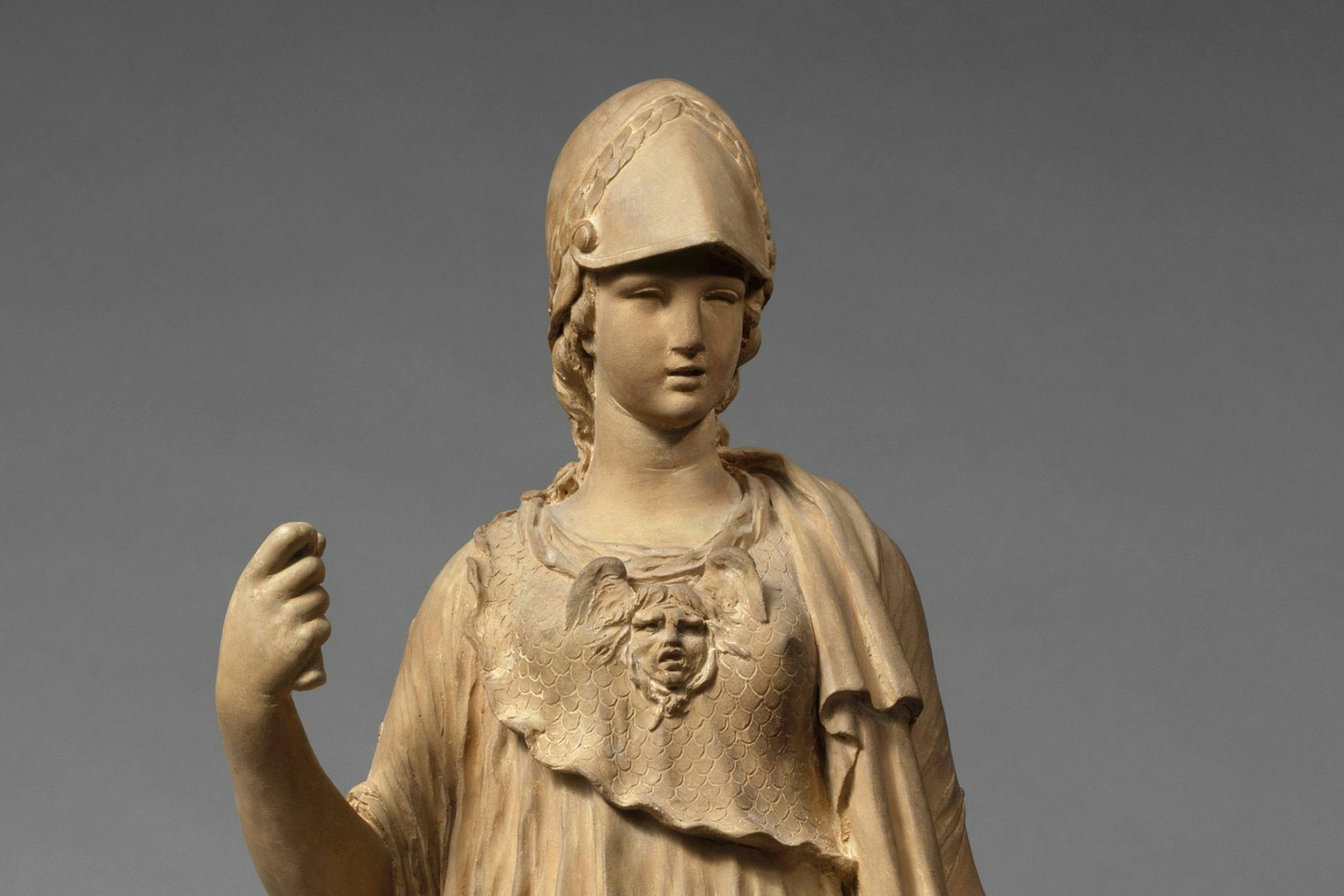
Overview
The wisest of the Roman deities, Minerva was a goddess of intelligence, philosophy, craftsmanship, art, and inspiration. From her position in the heavens, she oversaw all things that required forethought and calculation. In later incarnations, Minerva was also seen as a military figure, as well as the fount through which all strategic and tactical thought flowed. Minerva ruled with Jupiter and Juno as part of the divine triumvirate known as the Capitoline Triad.
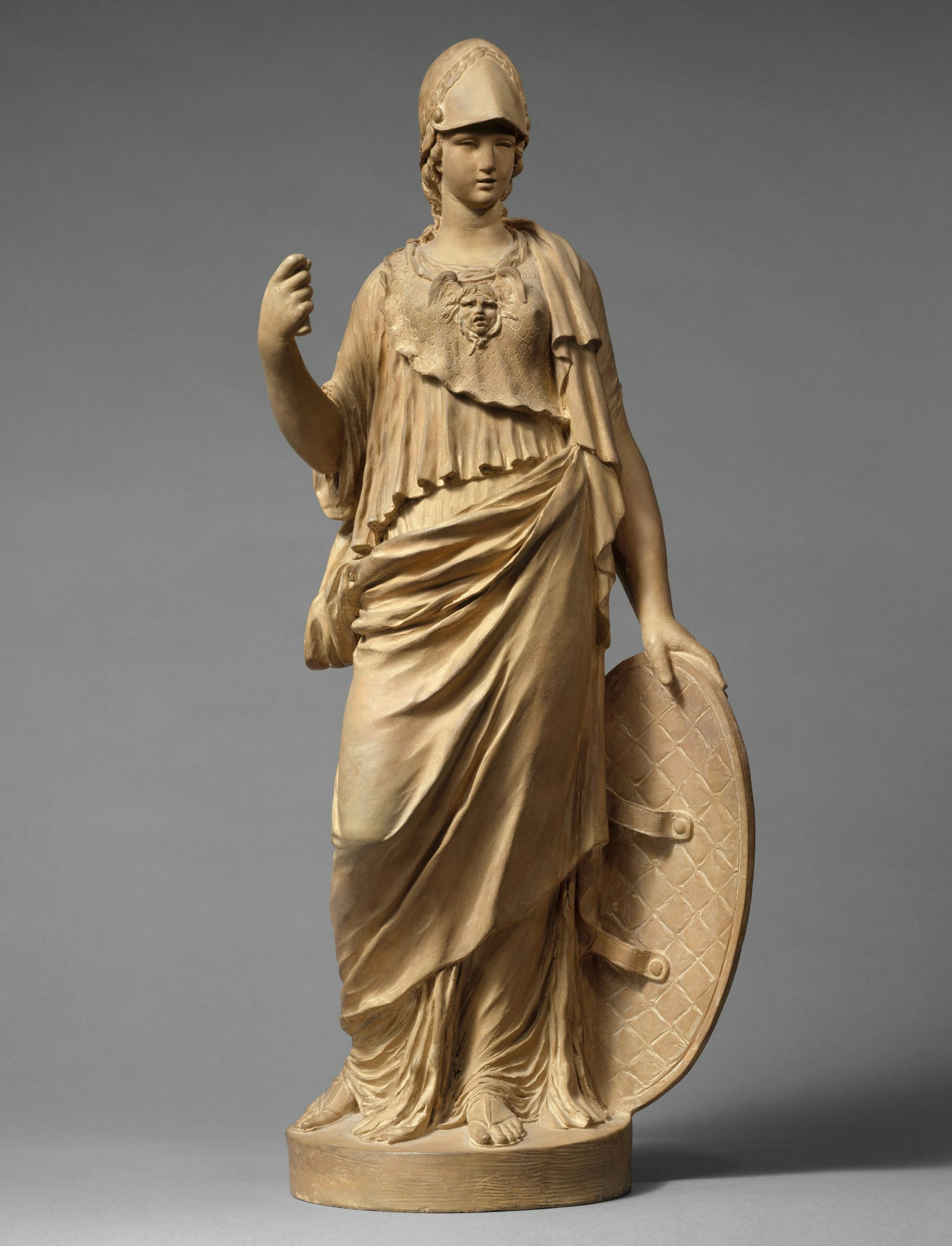
Inspired by Roman antiquities, this 18th century Minerva wears a floor-length chiton and an aegis fixed with a Medusa head thought to ward off evil. She carries a shield and wears a Corinthian battle helmet that is pushed back to reveal her features.
The Metropolitan Museum of ArtPublic DomainMinerva may well be the most quintessentially Roman of all Roman deities. Unlike Jupiter and Neptune, who were borrowed wholesale from Greek deities, Minerva evolved from an Etruscan deity known as Menrva. She was gradually Hellenized in the fourth and third centuries BCE, and took on more of Athena’s characteristics as the Romans took on more trappings of Greek civilization. During the same period, Minerva overtook Mars’ position in the Archaic Triad (composed of Jupiter, Quirinus, and Mars), forming the new Capitoline Triad. Her displacement of the raging war god Mars suggested a significant shift in Roman self-understanding and underscored its transition from provincial Italian power to Mediterranean superpower.
Revered by craftsmen, merchants, statesmen, military leaders, artists, and philosophers alike, Minerva was a central figure in the Roman mythos. Temples dedicated to Minerva were plentiful throughout the Roman Empire, and several festivals were held each year in her honor. As with other Roman deities, the worship of Minerva was eclipsed by the rise of Christianity, which came to dominate Roman hearts and minds in the fourth century CE.
Etymology
The Roman name “Minerva” took inspiration from the Etruscan deity Menrva, or perhaps Menerwā. The Etruscan name was itself borrowed from an older Italic deity called Meneswā or Menes-wo, meaning “she who remembers,” “she who knows,” or “she who measures.” Minerva’s name shared its root with Manasvini, a Hindu deity associated with virtue, intelligence, and the moon.[1]
Attributes
The wisest of all gods and goddesses, Minerva had a calculating mind that she used to achieve her aims. The chastest of Roman deities, Minerva spurned the advances of men and gods alike in order to retain her virginal purity.
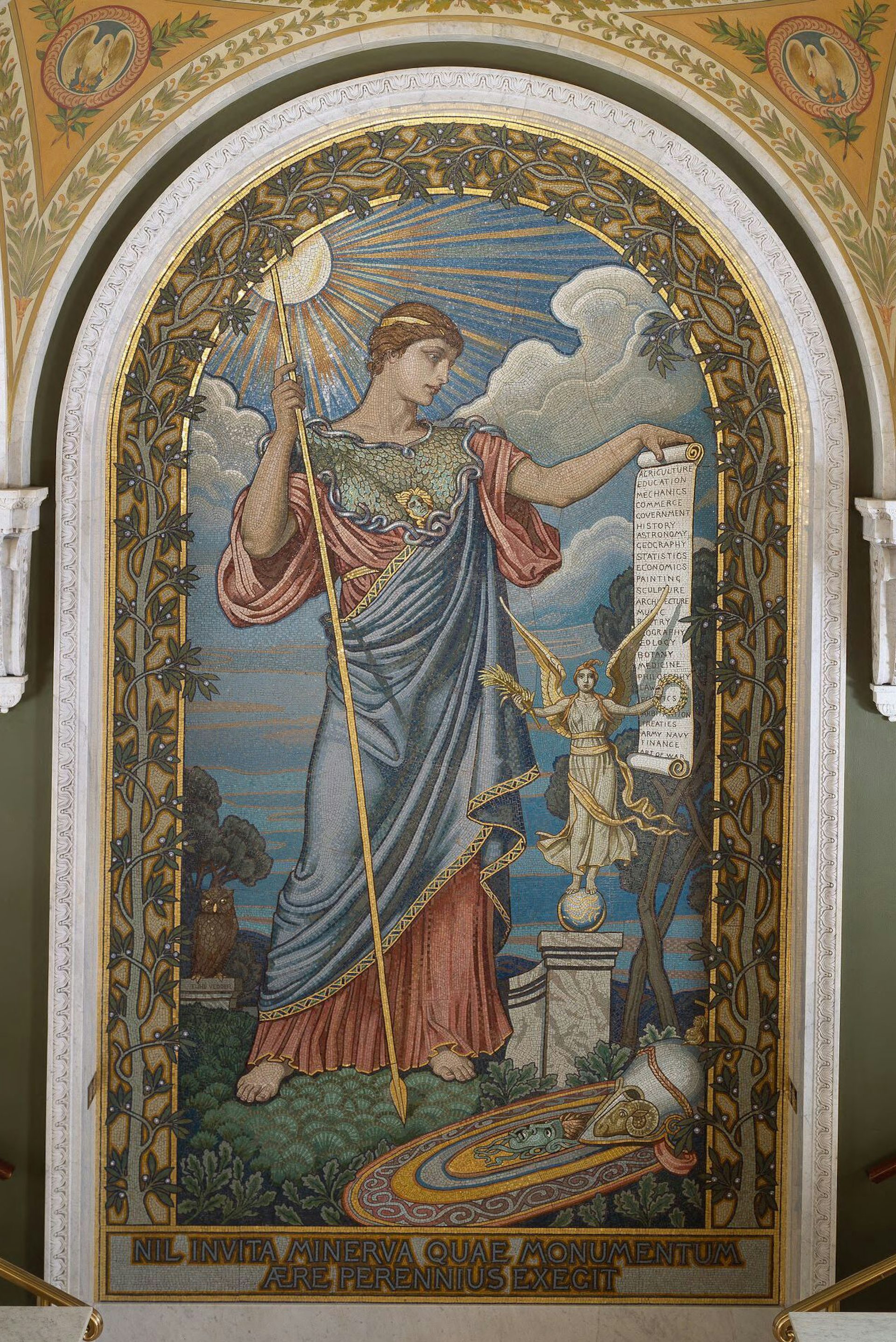
Minerva of Peace mosaic adorning the oldest building of the Library of Congress, Washington, D.C. Here Minerva holds a laurel wreath representing victory and a palm branch representing peace. Her shield and helmet are laid on the ground, though she still holds a spear to signify her vigilance.
Carol M. Highsmith / Library of Congress Public DomainAs a goddess of peace and the civilized arts, Minerva sometimes wore a chiton—a set of long robes worn to floor-length by a lady, and knee-length by men—and a crown of laurels. As the fierce goddess of warfare, Minerva would also wield a spear and don a Roman general’s armor, complete with a soldier’s helm and a small shield. Most depictions of the goddess portrayed her in this latter attire.
Family
In her Hellenic form, Minerva was the daughter of Jupiter, the king of the gods, and Metis, a giant or Titan. By way of lusty Jupiter, Minerva had many half siblings, including Mars, Bellona, Vulcan, and Juventus. Other half siblings included Mercury, the messenger god of commerce, sailing, and travel, Venus, the goddess of love and sexual desire, and Proserpina, the maiden goddess abducted by Pluto.
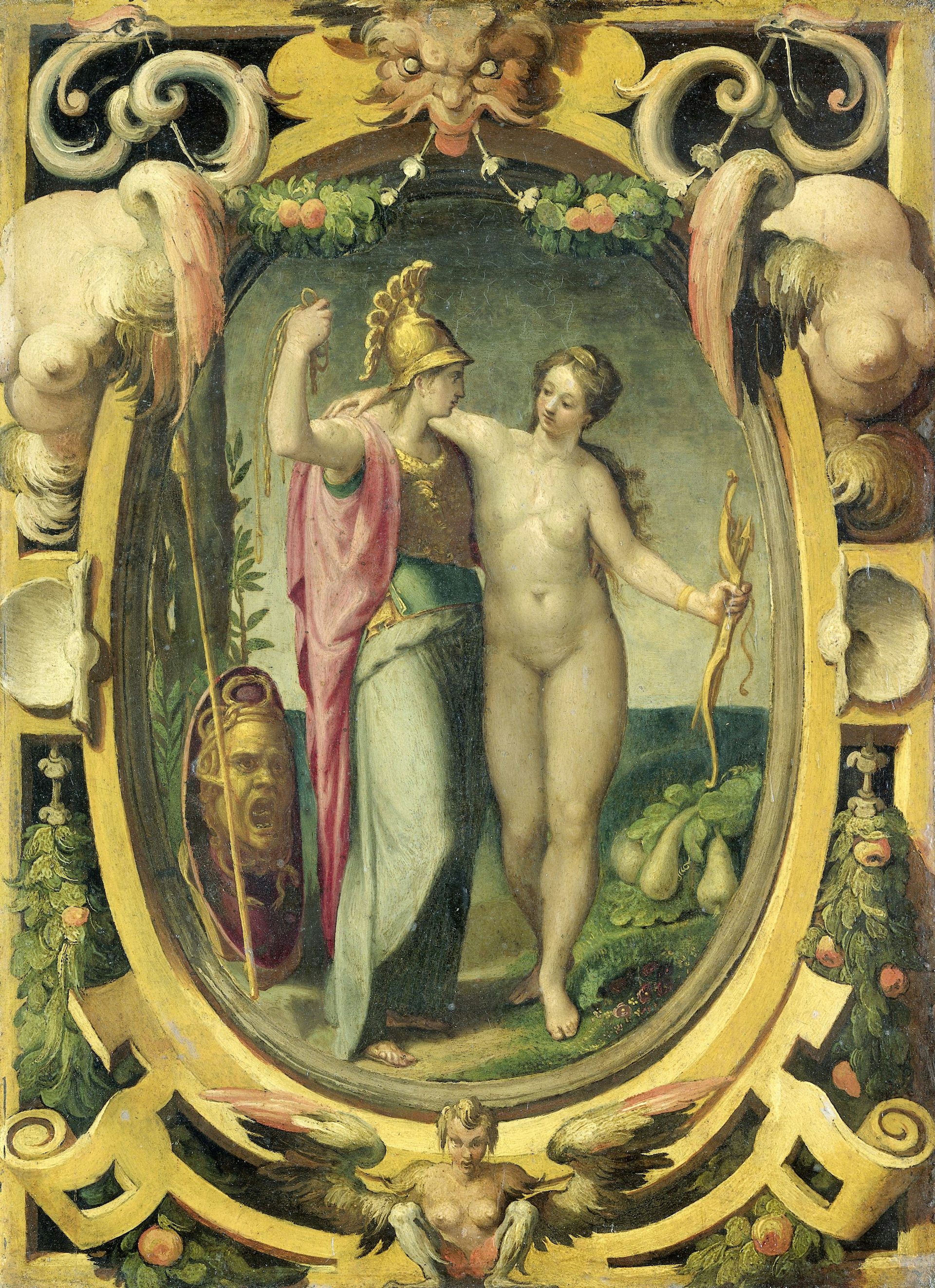
Venus and Minerva (c.1590-1620) by Pellegrino Tibaldi.
RijksmuseumPublic DomainAs a virginal goddess, Minerva never had any children of her own. She also never married.
Family Tree
Parents
Father
Mother
- Metis
Siblings
Brothers
Sisters
Mythology
Birth of Minerva
Later Romans appropriated the myths of the Greek goddess Athena and applied them to Minerva; thus, the Roman story of the birth of Minerva is identical to the Greek story of the birth of Athena. It began—as stories involving Jupiter often did—with his sexual promiscuity. In this case, Jupiter had an affair with a woman named Metis, who in the Greek tradition was described as a Titan. When Metis became pregnant, Jupiter, who had seized control of the universe by overthrowing his father Saturn, learned of a prophecy foretelling his downfall at the hands of his own son. Fearing that Metis’ unborn child would fulfill this prophecy, Jupiter swallowed Metis and her child whole, just as Saturn had swallowed Jupiter’s brothers and sisters.
Biding her time, the unborn Minerva plotted her emergence from the womb. At long last, she burst forth from Jupiter’s forehead, fully grown and ready for battle. Some accounts claimed that Vulcan, the god of metallurgy, served as a midwife of sorts by prying open Jupiter’s head with an axe and delivering Minerva; the moment has been the subject of artistic renderings both ancient and modern. Despite this rather inauspicious start to her relationship with her father, Minerva eventually became Jupiter’s favorite child.
Minerva, the Aeneid, and the Founding of Rome
According to Virgil’s Aeneid Minerva initially opposed the founding of Rome and despised its founding hero, the Trojan warrior Aeneas. In Virgil’s first-century BCE masterpiece, Minerva took the place of Athena, the Greek goddess spurned by Paris of Troy. Minerva’s grudge against the Trojans was tremendous and her vengeance severe. Virgil indicated that Minerva hatched the scheme that ultimately led to the sack of Troy. Using her gift of strategic inspiration, she implanted the idea of the Trojan horse into the mind of Ulysses (Odysseus in the Greek), who then directed the creation of the famous gift. Virgil called it “Minerva’s gift of death.”[2] When the Trojan dissenter Laocoon raised the alarm, claiming that the horse was a trick that spelled doom for Troy, Minerva sent two sea serpents to kill Laocoon’s sons and devour the father.
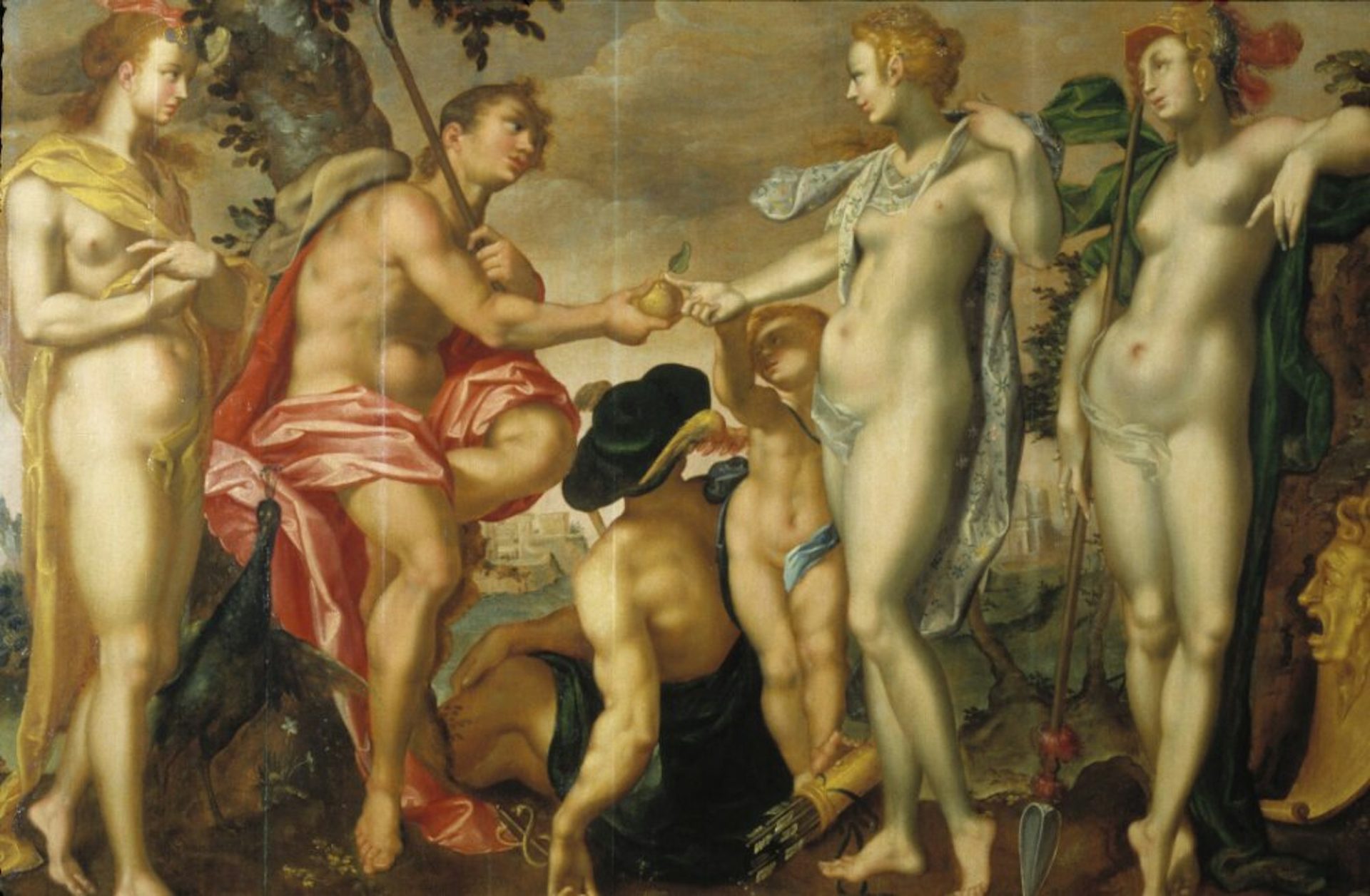
The Judgement of Paris by Michiel Jansz. van Mierevelt (1567-1641). In a classic scene, Minerva (far right) plots her revenge on the Trojans after being spurned by their prince.
Nationalmuseum (Sweden)Public DomainWhen Aeneas escaped from the devastated city, however, he carried away a small statuette of the goddess. Minerva still pursued Aeneas, but the Trojan hero eluded the wrath of the goddess and carried the statuette wherever he went. In time, Aeneas’ guardianship of the object placated Minerva, who read it as a sign of Aeneas’ devotion to her. Aeneas brought the statuette to Italy, and it eventually came to reside in the Temple of Vesta. According to legend, so long as Minerva’s token resided within the temple’s halls, the city of Rome would never be conquered.
Minerva and the Arachnids
A far quirkier tale contained in Ovid’s Metamorphoses of the early first century CE told of Minerva and the creation of spiders. The tale was a classic story of hubris in the face of the gods and the consequences thereof. It started when Arachne, a young girl and a talented weaver, boasted that her mastery of the craft even exceeded that of Minerva. When Minerva heard of this boast, she transformed herself into an old woman and counseled Arachne to rescind her claim. When Arachne defiantly repeated her conceit, the old woman challenged her to a contest.
Minerva wove a beautiful tapestry that depicted triumphantly winning the patronage of Athens as the other gods looked on. Though beautiful and well crafted, Arachne’s tapestry depicted many famous episodes in which male gods transformed themselves into humans and seduced mortal women. Such depictions were taboo, as it was deeply offensive to show the gods in the midst of such folly.
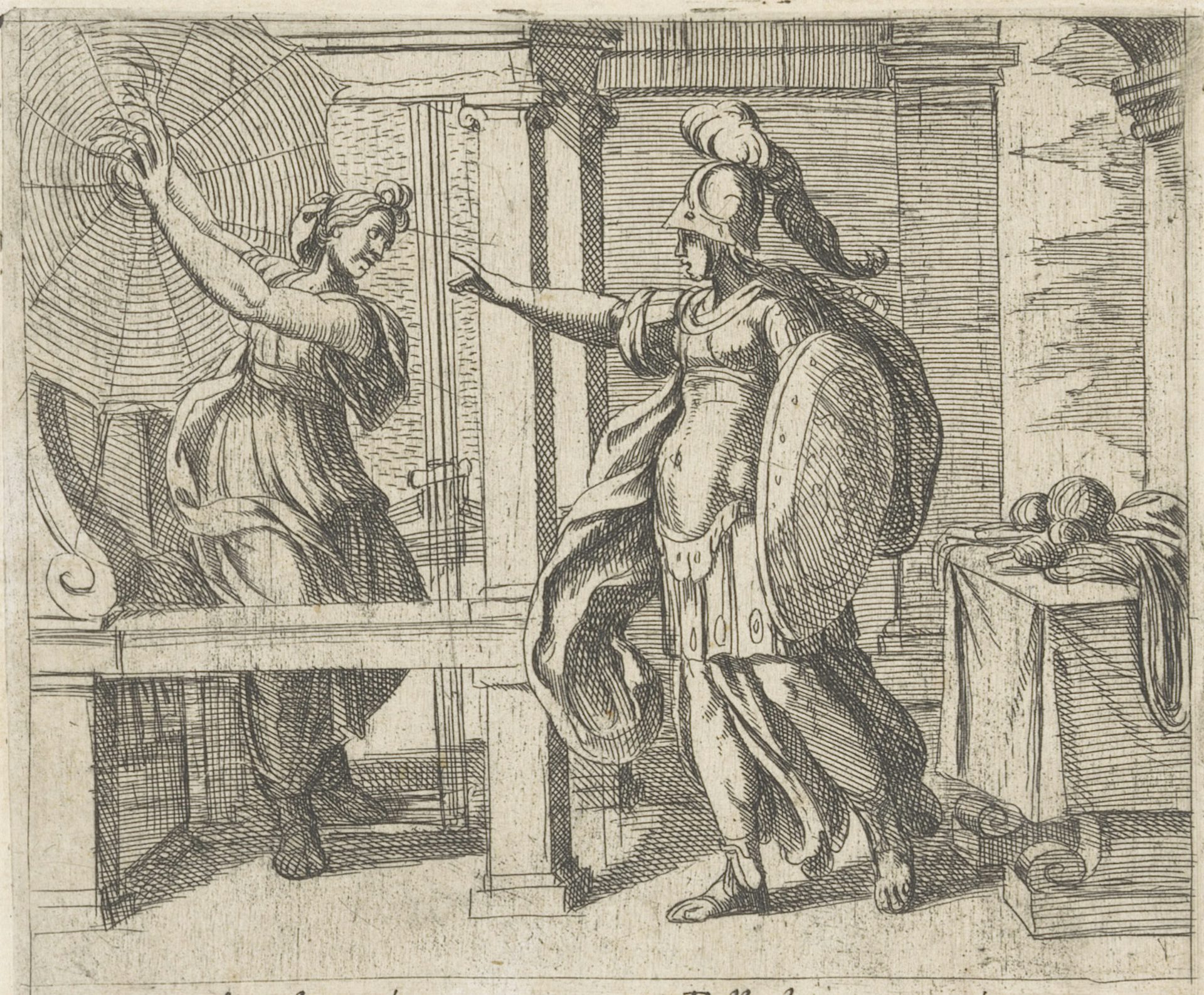
Taking inspiration from Ovid’s Metamorphoses, this 17th century etching depicts Minerva transforming Arachne into a spider
RijksmuseumPublic DomainNot about to stand by and let Arachne mock the gods, Minerva she struck the girl “three or four times” on the head. The pain and shame of the blows left Arachne hopeless, and she proceeded to string a noose around her neck and hang herself. Suddenly taking pity on the girl, Minerva saved Arachne from death by transforming her into a spider. As Ovid described it:
Pallas [Minerva], in pity, lifted her, as she hung there, and said these words, ‘Live on then, and yet hang, condemned one, but, lest you are careless in future, this same condition is declared, in punishment, against your descendants, to the last generation!’ Departing after saying this, she sprinkled her with the juice of Hecate’s herb, and immediately at the touch of this dark poison, Arachne’s hair fell out. With it went her nose and ears, her head shrank to the smallest size, and her whole body became tiny. Her slender fingers stuck to her sides as legs, the rest is belly, from which she still spins a thread, and, as a spider, weaves her ancient web.[3]
Minerva and Roman State Religion
Minerva was a central object of worship among the Romans, who viewed the goddess as a source of wisdom, inspiration, and military success. The Romans worshipped Minerva at several locations throughout the city. At the Temple of Minerva Medica on the Esquiline Hill in Rome, Minerva was observed as a patron of healing. Minerva also had a temple on the Mons Caelius, another of the seven hills of Rome. Her chief Roman temple, however, was situated on Aventine Hill, near the guild halls for actors, writers, and other craftsmen. As “Aventine Minerva” she was celebrated as the bringer of skill and inspiration. Outside the city, temples to Minerva spread to the furthest reaches of the Roman Empire.

The Temple of Minerva at the forum of Sufetula, an ancient Roman city in what is now Sbeitla, Tunisia. Constructed in the third century CE, the Sufetula Temple of Minerva testified to the goddess's broad geographic appeal.
Dennis JarvisCC BY-SA 2.0The Romans dedicated several festivals to Minerva and feted the goddess throughout the calendar year. Her chief festival—known as the Quinquatria—featured five days of celebration beginning on the fifth after the Ides of March, or March 19. The celebration marked the beginning of the campaign season, when the Roman armies marched away to war. Securing Minerva’s goodwill at such an auspicious time was thought to secure the victory for Roman armies abroad. Another version of the festival, called the Minusculae Quinquatria (or “Lesser Quinquatria”) was celebrated on the Ides of June.
The Quinquatria had previously been the domain of Mars, who also served as a member of the Archaic Triad. The shift to Minerva marked the evolution of Roman culture and ideology. As Hellenic values and ideas seeped into Roman thought, the Romans increasingly began to view themselves as the stewards of a vast Mediterranean empire whose maintenance required the patient forethought of Minerva, rather than the violent rage of Mars.
Pop Culture
Minerva has maintained a lively presence in popular culture, albeit through unconventional means. There are, for instance, a profusion of Minerva statues in world locales. A statue of Minerva famously adorned the train station in Pavia, Italy, while another resided in the center of the so-called “Minerva Roundabout,” in Guadalajara, Mexico. There are also Minerva statues in Chester, England, Portland, Maine, and Ballarat, Australia. This final statue sits (appropriately) atop the Ballarat Mechanic’s Institute.
As a source of wisdom and symbol of patience, Minerva has served as a fitting insignia for many colleges and universities. Minerva adorned the seal of the University of North Carolina in Greensboro, as well as the State University of New York in Albany. Wells College in New York also featured Minerva on its seal. Wells College was also home to a Minerva statue, which students ceremoniously decorated each fall to inaugurate the coming school year.
Finally, Minerva has been displayed prominently on the state seal of California since 1849. In the seal, she was depicted wearing military garb and overlooking San Francisco Bay while ships sail its waters and nearby miners dig for gold.